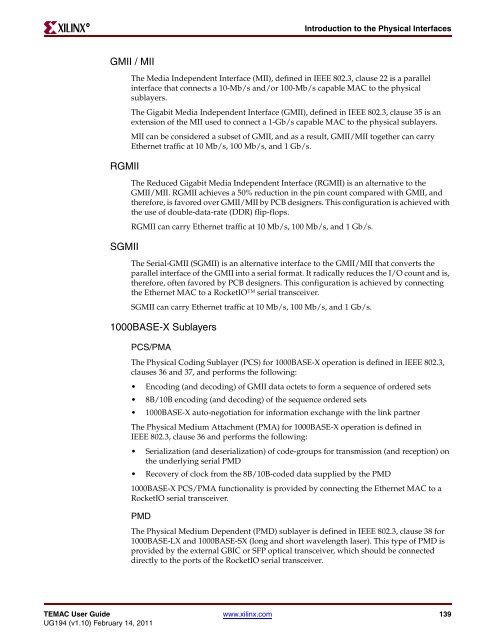Xilinx UG194 Virtex-5 FPGA Embedded Tri-Mode Ethernet MAC ...
Xilinx UG194 Virtex-5 FPGA Embedded Tri-Mode Ethernet MAC ...
Xilinx UG194 Virtex-5 FPGA Embedded Tri-Mode Ethernet MAC ...
You also want an ePaper? Increase the reach of your titles
YUMPU automatically turns print PDFs into web optimized ePapers that Google loves.
R<br />
GMII / MII<br />
RGMII<br />
SGMII<br />
Introduction to the Physical Interfaces<br />
The Media Independent Interface (MII), defined in IEEE 802.3, clause 22 is a parallel<br />
interface that connects a 10-Mb/s and/or 100-Mb/s capable <strong>MAC</strong> to the physical<br />
sublayers.<br />
The Gigabit Media Independent Interface (GMII), defined in IEEE 802.3, clause 35 is an<br />
extension of the MII used to connect a 1-Gb/s capable <strong>MAC</strong> to the physical sublayers.<br />
MII can be considered a subset of GMII, and as a result, GMII/MII together can carry<br />
<strong>Ethernet</strong> traffic at 10 Mb/s, 100 Mb/s, and 1 Gb/s.<br />
The Reduced Gigabit Media Independent Interface (RGMII) is an alternative to the<br />
GMII/MII. RGMII achieves a 50% reduction in the pin count compared with GMII, and<br />
therefore, is favored over GMII/MII by PCB designers. This configuration is achieved with<br />
the use of double-data-rate (DDR) flip-flops.<br />
RGMII can carry <strong>Ethernet</strong> traffic at 10 Mb/s, 100 Mb/s, and 1 Gb/s.<br />
The Serial-GMII (SGMII) is an alternative interface to the GMII/MII that converts the<br />
parallel interface of the GMII into a serial format. It radically reduces the I/O count and is,<br />
therefore, often favored by PCB designers. This configuration is achieved by connecting<br />
the <strong>Ethernet</strong> <strong>MAC</strong> to a RocketIO serial transceiver.<br />
SGMII can carry <strong>Ethernet</strong> traffic at 10 Mb/s, 100 Mb/s, and 1 Gb/s.<br />
1000BASE-X Sublayers<br />
PCS/PMA<br />
The Physical Coding Sublayer (PCS) for 1000BASE-X operation is defined in IEEE 802.3,<br />
clauses 36 and 37, and performs the following:<br />
Encoding (and decoding) of GMII data octets to form a sequence of ordered sets<br />
8B/10B encoding (and decoding) of the sequence ordered sets<br />
1000BASE-X auto-negotiation for information exchange with the link partner<br />
The Physical Medium Attachment (PMA) for 1000BASE-X operation is defined in<br />
IEEE 802.3, clause 36 and performs the following:<br />
Serialization (and deserialization) of code-groups for transmission (and reception) on<br />
the underlying serial PMD<br />
Recovery of clock from the 8B/10B-coded data supplied by the PMD<br />
1000BASE-X PCS/PMA functionality is provided by connecting the <strong>Ethernet</strong> <strong>MAC</strong> to a<br />
RocketIO serial transceiver.<br />
PMD<br />
The Physical Medium Dependent (PMD) sublayer is defined in IEEE 802.3, clause 38 for<br />
1000BASE-LX and 1000BASE-SX (long and short wavelength laser). This type of PMD is<br />
provided by the external GBIC or SFP optical transceiver, which should be connected<br />
directly to the ports of the RocketIO serial transceiver.<br />
TE<strong>MAC</strong> User Guide www.xilinx.com 139<br />
<strong>UG194</strong> (v1.10) February 14, 2011

















